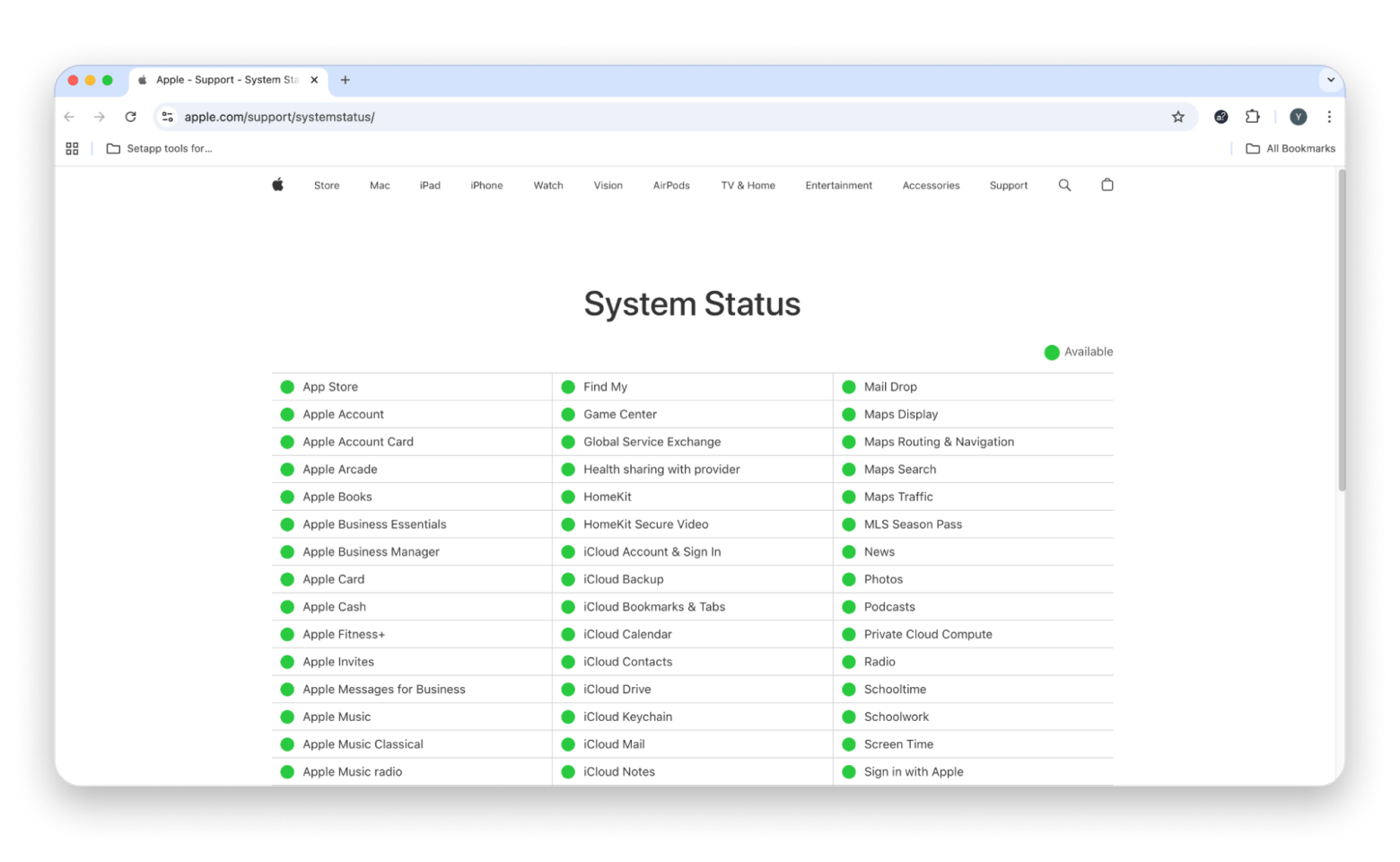How to update apps on iPhone or iPad: Check out my top methods in 2025
- To turn on automatic app updates on iPhone or iPad:
Go to Settings > Apps > App Store > App Updates to ensure your device installs new versions as they become available. - To update selectively (manually):
Head to the App Store > Profile > Upcoming Automatic Updates to manually update individual apps or tap Update All to refresh everything at once. - If apps aren’t updating:
Check that you’re signed in with the correct Apple Account, connected to the internet, and running the latest iOS version. If the App Store still doesn’t show updates, reinstalling the app may resolve the issue.
- Manage all your iPhone and iPad apps right from your Mac:
Update, back up, and transfer in one click using AnyTrans for iOS. Try it with a free 7-day Setapp trial + over 250 other apps.
One day, you might realize your iPhone apps haven’t been updated in ages — without you even noticing. This guide is for anyone who wants to learn how to automatically update apps on iPhone and iPad and never worry about it again. Useful tricks included.
How to update apps on iPhone or iPad: Quick overview
For detailed, step-by-step instructions — with screenshots and real-life examples — scroll down.
| Your goal? | Try this! |
| Enable automatic app updates | Settings > Apps > App Store > Turn on App Updates |
| Manually check for updates | App Store > Profile icon > Upcoming Automatic Updates > Choose apps or tap Update All |
| Update all apps quickly | App Store > Profile picture (icon) > Update All (under Upcoming Automatic Updates) |
| No Updates visible / app not updating |
1. Verify correct Apple Account signed in. 2. Check internet connection. 3. Update to latest iOS. 4. Check Apple System Status (green = OK). 5. Reinstall the app. |
| Update via Mac (Alternative) | Connect iPhone to Mac > Open AnyTrans for iOS > Apps tab > Click Update |
| Sync apps between iPhone & iPad | Settings > [Your Name] > iCloud > See All > Turn on desired apps |
| Solve iPad-specific update issues | • No Wi-Fi • Low storage • Older iPad model (incompatible with new app versions) → Free up space, update iPadOS, or use compatible apps. Click to see all iPad generations in order. |
How to check for app updates on iPhone
To check for app updates on an iPhone, open the App Store and look for pending updates.
To manually check for app updates:
- Open App Store > Go to your profile.
- Under Upcoming Automatic Updates, you’ll see a list of apps to be updated.
- Choose manually which one you need to update.

How to turn on app updates on my iPhone
When auto updates are switched on, on your iPhone or iPad everything will get updated regularly. You won’t need to think about it; you’ll always be running the freshest version possible of your favorite apps.
To turn on automatic app updates on your iPhone and iPad:
- Go to Settings > Apps.
- Tap App Store > Turn on App Updates.
How to quickly update ALL apps on iPhone
If you don’t know how to make apps update automatically on your iPhone and want your device to do all the work, it’s super easy.
Here's how to manually update apps on iPhone: just tap Update All right under Upcoming Automatic Updates.

How to manually update apps on iPhone and iPad
To manually update apps on iPhone and iPad, open App Store > Go to your profile and check Upcoming Automatic Updates. Choose manually which one you need to update.
I’ve found that each version of iOS can vary slightly regarding how to update your apps. When you’re updating them for different versions of iOS, their compatibility with older features is definitely worth considering.
When developers are creating and updating, they’ve got to think about what to keep and what to get rid of when they’re working on updates, just like when you declutter your home. They must do the same to ensure the app is running smoothly.
Here’s what can affect how apps update on different iOS versions:
- API changes: New iOS versions mean that developers have to update code to use the latest API version but offer fallback solutions for those people using older versions of iOS. You can check out the full list of iOS versions in our article.
- UI design differences: Each iOS has UI elements that vary slightly, which affects the app’s design. So, when you use a newer iOS app, it will have a different look or feel.
- Feature compatibility: When developing new iOS settings, developers must carefully consider which features to keep enabled and which to disable.
- Backward compatibility: App functionality must be kept available and running on older versions of iOS, even if users can’t always take advantage of all the new features.
Personal tipIf you try all the methods but the apps still haven’t been updated, then use AnyTrans for iOS. It’s a cool tool for managing all your iOS devices, so if you want to update the apps, open AnyTrans for iOS on your Mac > Connect your iPhone to your Mac with a cable > In the device manager tab, click Apps > Update the apps with a click. |

Why can't I see updates? Where is the update option in App Store?
If the App Store does not appear to have an update, but you know one is available, do this:
- Check that you’re signed in with the right Apple Account.
- Once you’ve verified this, check that your internet connection is fine and dandy.
- Lastly, ensure your device software is up to date.
Try uninstalling and reinstalling the app once this is done. It may update from this simple step.
Quick question — which camp are you in?Let’s say someone says, “I always update my software and operating system.”Would you nod and say “Always”? Or maybe “Sometimes,” “Rarely,” or even “Never”? We asked* people the same thing — and here are the results:
*Source: MacPaw’s 2024 Scams and Disinformation Survey |
Why are there no app updates on iPhone?
Looks like your phone isn’t updating any apps right now. No need to stress!
Here are some reasons why there are no app updates on your iPhone:
- You have automatic updates turned off in the Settings app.
- You have a poor or no internet connection.
- You need to update your iOS.
- There are problems with App Store servers.
- You might need to manually check for updates within the App Store.
Whatever the reason, starting with your device first is always a good idea. Here’s the complete guide on how to update your iPhone.

Why apps won’t update on cellular data?
Your iPhone may not allow app updates when you’re using mobile data instead of Wi-Fi. You can change this setting in the Settings app:
- Open the Settings app.
- Tap Apps > App Store.
- Scroll down to Mobile Data.
- If Automatic Downloads is turned off, toggle it on to enable automatic app updates while using cellular data.
You can also adjust the download size limit when on cellular data. By default, your iPhone asks for confirmation when an app is over 200 MB, but you can change this to Always Allow or Always Ask.
It’s easy to learn how to update all apps on iPhone
With a few simple taps of a button, you can make sure your iPhone and iPad are running as smoothly as possible, with all their apps updated regularly.
In case you can't update apps in the native way, you can use AnyTrans for iOS. Want to try the app? It’s available on Setapp. The platform offers over 250 apps to try out under a single subscription. Setapp offers a free 7-day trial if you’d like to explore all intuitive apps for keeping your iPhone and iPad in tip-top condition.
There are 250 apps to try out, and the possibilities are endless! So, whether you want your device to run more efficiently or simply want some cool ideas for apps that help with streaming entertainment, we’ve got it all.
FAQ
How do I match my iPhone and iPad apps?
To match apps on your iPhone and iPad, sync apps and data using iCloud:
- Go to the Settings app > Apple Account.
- Tap iCloud.
- Tap See All next to Saved to iCloud.
- Turn on each app you want to sync.
Why can't I update apps on my iPad?
You can’t update apps because:
- Your iPad might not be connected to the Wi-Fi
- You’ve run out of storage space
- Older iPads may not support newer apps
Why is my app not updating on iPhone?
Your iPhone might not be updating apps if it has no internet connection or not enough storage space. If it’s running a very old iOS, it may simply be too old to update the apps and is no longer supported by Apple. Try turning your iPhone off and on again to see if that helps. If all else fails and you can’t find an obvious cause, it’s best to contact Apple Support to see if they can assist you.






